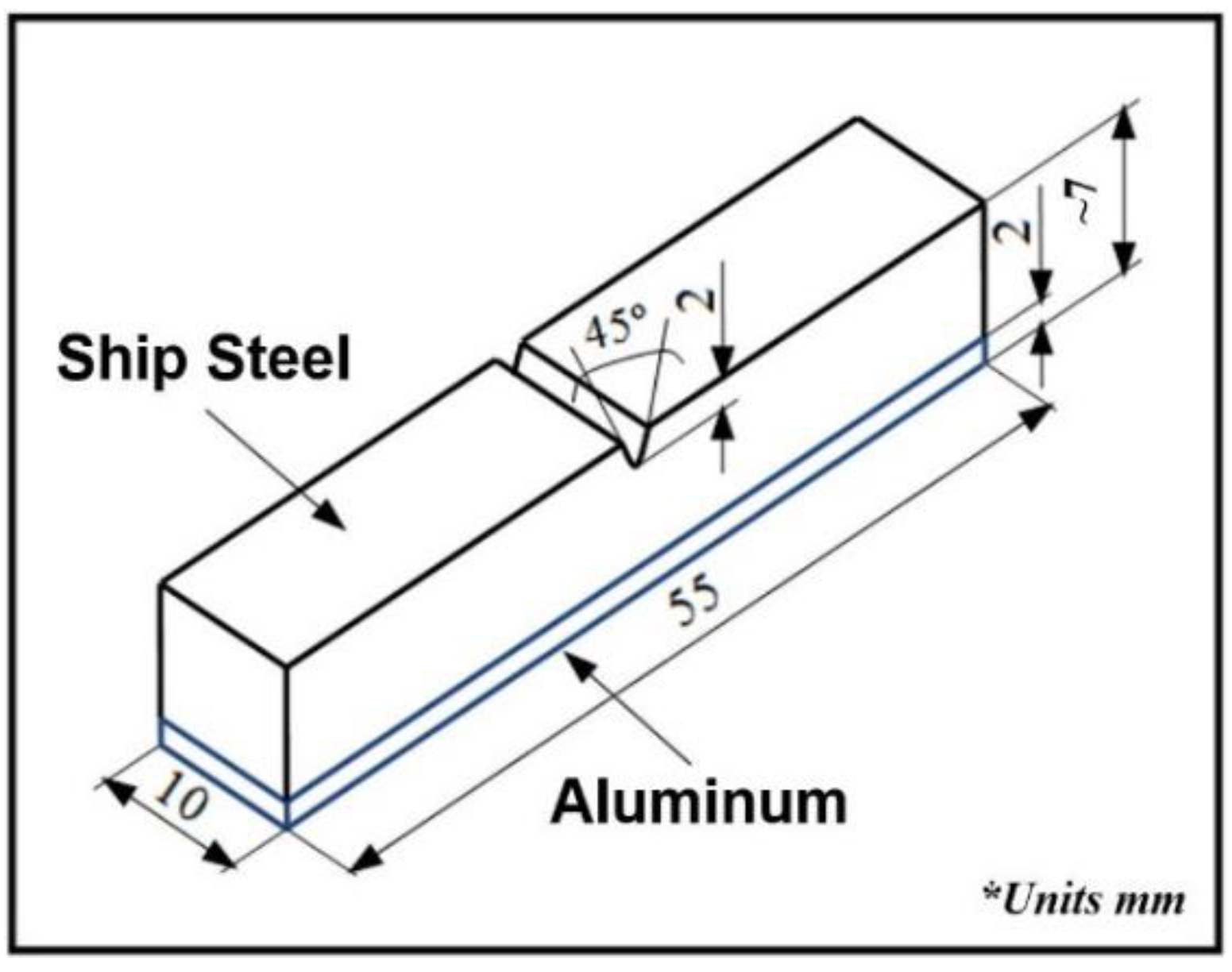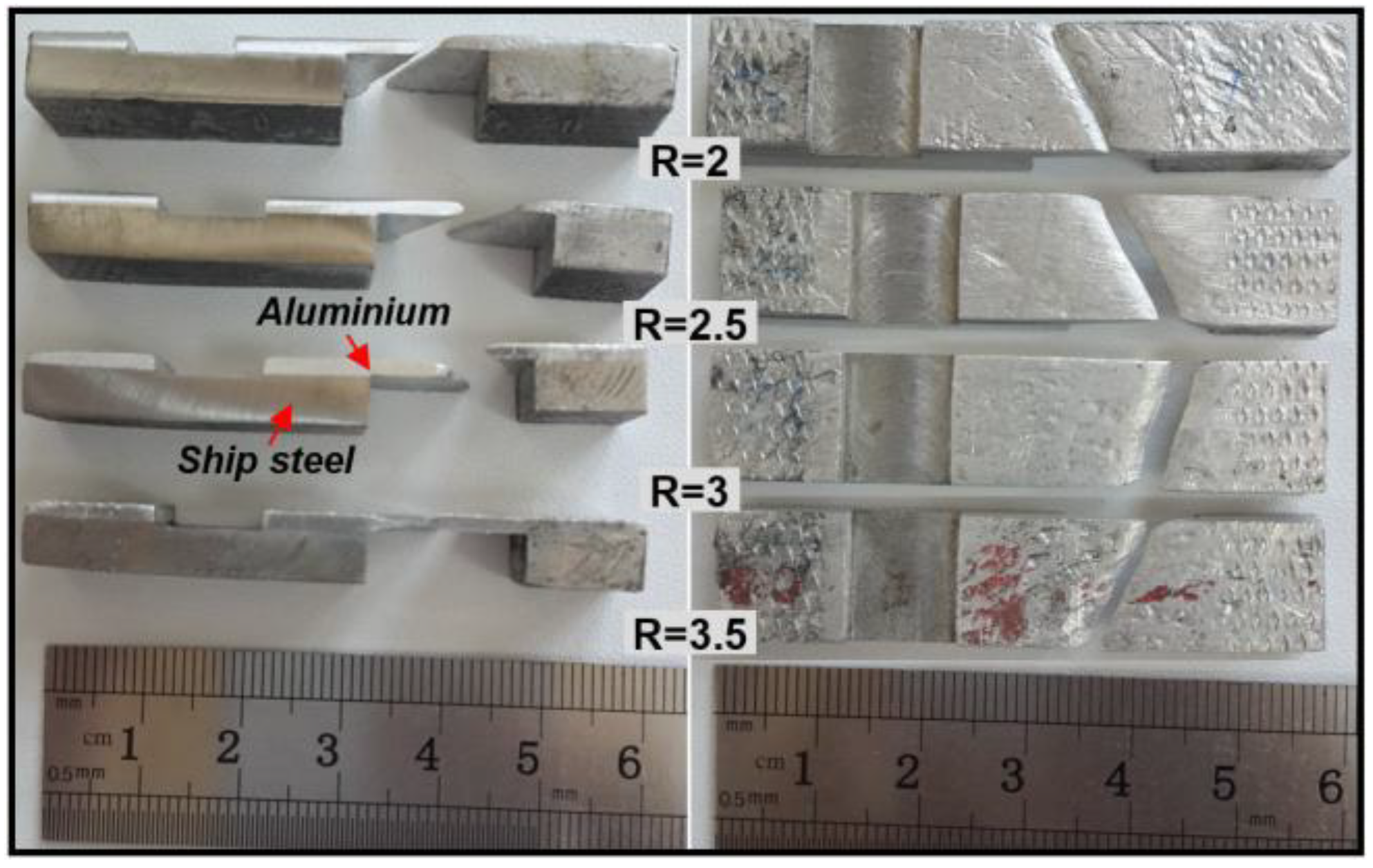Microstructural, Mechanical and Corrosion Investigations of Ship Steel-Aluminum Bimetal Composites Produced by Explosive Welding
Abstract
:1. Introduction
2. Experimental Procedure
3. Results and Discussions
3.1. Metallographic Examination
3.2. SEM and EDS Analysis
3.3. Tensile-Shear Test Results
3.4. Charpy Impact Toughness Results
3.5. Bending Test Results
3.6. Twisting Test Results
3.7. Microhardness Results
3.8. Neutral Salt Spray Test Results
4. Conclusions
- In the ship steel-aluminum bimetal composite samples, waving in the interface increased at increasing explosive ratios and in parallel with this, the wavelength and amplitude increased. In addition, the grains close to the bonding interface extended parallel to the explosion direction as a result of the sudden cold plastic deformation that occurred due to the pressure applied during the explosive welding. This effect gradually disappeared at distances moving further away from the interface.
- The SEM and EDS investigations on the ship steel-aluminum bimetal composite joining interface revealed that a flat interface was obtained at a low explosive ratio and no intermetallic formation was observed, but as the explosive ratio increased, a wavy structure was formed by mechanical interlocking at the interface and some intermetallic compounds (FeAl3 + αAl and α2) were formed.
- As a result of tensile-shear tests applied to the ship steel-aluminum bimetal composite samples, tensile-shear strength increased at increasing explosive ratios. In addition, no separation was present in the bonding interface of the composite samples. The SEM images of the fracture surfaces revealed ductile fractures having a matte and fibrous appearance.
- As a result of the notch impact test performed at room temperature, the impact toughness decreased due to increased deformation hardening at increasing explosive ratios. Additionally, cracking occurred in the ship steel (base plate) side of the ship steel-aluminum bimetal composites, and although bending was seen in the aluminum (cladding plate) side, no separation was present.
- The two-way bending tests performed by bending samples 180° revealed no visible cracks, fractures, or separation in the bonding interface of the bimetal composite samples that were produced at different explosive ratios.
- After the 360° twisting test was applied to the bimetal composite samples, no faults were seen in the bonding interface of any of the composites.
- The hardness test showed that the highest hardness value was measured at the bonding interface, followed by the outer surface of the plates (ship steel and aluminum) and the thick central areas of the plates. Moreover, the hardness values that were measured for the bimetal composite samples increased at increasing explosive ratios.
- As a result of salt spray tests, the aluminum cladded to the ship steel surface exhibited greater corrosion resistance when compared to that of the ship steel.
- In the microstructure studies applied to the ship steel-aluminum bimetal composite specimens, no unbonded areas were seen at the joining interface. After mechanical tests, no separation was observed at the joining interface, and after corrosion tests, no corrosion was found on the aluminum side of the joining. It can be stated that the R = 2 explosive ratio is the best choice for reducing deformation at the joining interface in the production of ship steel-aluminum bimetal composites.
Funding
Acknowledgments
Conflicts of Interest
References
- Kaya, Y.; Kahraman, N. An investigation into the explosive welding/cladding of grade a ship steel/AISI 316L austenitic stainless steel. Mater. Des. 2013, 52, 367–372. [Google Scholar] [CrossRef]
- Li, X.; Ma, H.; Shen, Z. Research on explosive welding of aluminum alloy to steel with dovetail grooves. Mater. Des. 2015, 87, 815–824. [Google Scholar] [CrossRef]
- Young, G.A.; Banker, J.G. Explosion welded, bi-metallic solutions to dissimilar metal joining. In Proceedings of the 13th Offshore Symposium, Houston, YX, USA, 24 February 2004; pp. 1–6. [Google Scholar]
- Koschlig, M.; Veehmayer, M.; Raabe, D. Production of steel-light metal compounds with explosive metal cladding. In Proceedings of the 3rd International Conference on High Speed Forming, Dortmund, Germany, 11–12 March 2008; pp. 23–32. [Google Scholar]
- Wang, J.M.; Zhang, Y.A. A study on weldability of aluminum alloy-aluminum-steel transition joints. Adv. Mater. Res. 2013, 631, 713–716. [Google Scholar] [CrossRef]
- Tricarico, L.; Spina, R. Experimental investigation of laser beam welding of explosion-welded steel/aluminum structural transition joints. Mater. Des. 2010, 31, 1981–1992. [Google Scholar] [CrossRef]
- Tricarico, L.; Spina, R.; Sorgente, D.; Brandizzi, M. Effects of heat treatments on mechanical properties of Fe/Al explosion-welded structural transition joints. Mater. Des. 2009, 30, 2693–2700. [Google Scholar] [CrossRef]
- Tricarico, L.; Spina, R. Mechanical strength of Fe/Al structural transition joints subject to thermal loading. Arch. Mater. Sci. Eng. 2009, 37, 85–93. [Google Scholar]
- Mousavi, S.A.A.; Barrett, L.M.; Al-Hassani, S.T.S. Explosive welding of metal plates. J. Mater. Process. Technol. 2008, 1–3, 224–239. [Google Scholar] [CrossRef]
- Guo, X.; Wang, H.; Liu, Z.; Wang, L.; Ma, F.; Tao, F. Interface and performance of clam steel/aluminum clad tube prepared by explosive bonding method. Int. J. Adv. Manuf. Technol. 2016, 82, 543–548. [Google Scholar] [CrossRef]
- Sun, X.-J.; Tao, J.; Guo, X.-Z. Bonding properties of interface in Fe/Al clad tube prepared by explosive welding. J. Trans. Nonferrous Met. Soc. China 2011, 21, 2175–2180. [Google Scholar] [CrossRef]
- Guo, X.; Tao, J.; Wang, W.; Li, H.; Wang, C. Effects of the inner mould material on the aluminium-316L stainless steel explosive clad pipe. Mater. Des. 2013, 49, 116–122. [Google Scholar] [CrossRef]
- Kaya, Y.; Kahraman, N.; Durgutlu, A.; Gülenç, B. Investigation of the microstructural, mechanical and corrosion properties of grade a ship steel-duplex stainless steel composites produced via explosive welding. Metall. Mater. Trans. A 2017, 48, 3721–3733. [Google Scholar] [CrossRef]
- Szachogluchowicz, I.; Sniezek, L.; Hutsaylyuk, W. Low cycle fatigue properties of AA2519–Ti6Al4V laminate bonded by explosion welding. Eng. Fail. Anal. 2016, 69, 77–87. [Google Scholar] [CrossRef]
- Miao, G.; Ma, H.; Shen, Z.; Yu, Y. Research on honeycomb structure explosives and double sided explosive cladding. Mater. Des. 2014, 63, 538–543. [Google Scholar] [CrossRef]
- Acarer, M.; Gülenç, B.; Fındık, F. The influence of some factors on steel/steel bonding quality on their characteristics of explosive welding joints. J. Mater. Sci. 2004, 39, 6457–6466. [Google Scholar] [CrossRef]
- Acarer, M.; Gülenç, B.; Fındık, F. Investigation of explosive welding parameters and their effects on microhardness and shear strength. Mater. Des. 2003, 24, 659–664. [Google Scholar] [CrossRef]
- Kahraman, N.; Gülenç, B.; Fındık, F. Joining of titanium/stainless steel by explosive welding and effect on interface. J. Mater. Process. Technol. 2005, 169, 127–133. [Google Scholar] [CrossRef]
- Yazdani, M.; Toroghinejad, M.R.; Hashemi, S.M. Investigation of microstructure and mechanical properties of St37 steel-Ck60 steel joints by explosive cladding. J. Mater. Eng. Perform. 2015, 24, 4032–4043. [Google Scholar] [CrossRef]
- Durgutlu, A.; Gülenç, B.; Fındık, F. Examination of copper/stainless steel joints formed by explosive welding. Mater. Des. 2005, 26, 497–507. [Google Scholar] [CrossRef]
- Chu, Q.L.; Zhang, M.; Li, J.H.; Jin, Q.; Fan, Q.Y.; Xie, W.W.; Luo, H.; Bi, Z.Y. Experimental investigation of explosion-welded Cp-Ti/Q345 bimetallic sheet filled with Cu/V based flux-cored wire. Mater. Des. 2015, 67, 606–614. [Google Scholar] [CrossRef]
- Fındık, F. Recent developments in explosive welding. Mater. Des. 2011, 32, 1081–1093. [Google Scholar] [CrossRef]
- Zhang, L.J.; Pei, Q.; Zhang, J.X.; Bi, Z.Y.; Li, P.C. Study on the microstructure and mechanical properties of explosive welded 2205/X65 bimetallic sheet. Mater. Des. 2014, 64, 462–476. [Google Scholar] [CrossRef]
- Mastanaiah, P.; Madhusudhan Reddy, G.; Satya Prasad, K.; Murthy, C.V.S. An investigation on microstructures and mechanical properties of explosive cladded C103 niobium alloy over C263 nimonic alloy. J. Mater. Process. Technol. 2014, 214, 2316–2324. [Google Scholar] [CrossRef]
- Hoseini Athar, M.M.; Tolaminejad, B. Weldability window and the effect of interface morphology on the properties of Al/Cu/Al laminated composites fabricated by explosive welding. Mater. Des. 2015, 86, 516–525. [Google Scholar] [CrossRef]
- Mazar Atabaki, M.; Nikodinovski, M.; Chenier, P.; Ma, J.; Harooni, M.; Kovacevic, R. Welding of aluminum alloys to steels: An overview. J. Manuf. Sci. Prod. 2014, 14, 59–78. [Google Scholar] [CrossRef]
- Xie, M.X.; Zhang, L.J.; Zhang, G.F.; Zhang, J.X.; Bi, Z.Y.; Li, P.C. Microstructure and mechanical properties of Cp-Ti/X65 bimetallic sheets fabricated by explosive welding and hot rolling. Mater. Des. 2015, 87, 181–197. [Google Scholar] [CrossRef]
- Asemabadi, M. Sedighi, M.; Honarpisheh, M. Investigation of cold rolling influence on the mechanical properties of explosive-welded Al/Cu bimetal. Mater. Sci. Eng. A 2012, 558, 144–149. [Google Scholar] [CrossRef]
- Loureiro, A.; Mendes, R.; Ribeiro, J.B.; Leal, M.; Galvao, I. Effect of explosive mixture on quality of explosive welds of copper to aluminium. Mater. Des. 2016, 95, 256–267. [Google Scholar] [CrossRef]
- Kaçar, R.; Acarer, M. An investigation on the explosive cladding of 316L stainless steel-DIN-P355GH steel. J. Mater. Process. Tech. 2004, 152, 91–96. [Google Scholar] [CrossRef]
- Gülenç, B.; Kaya, Y.; Durgutlu, A.; Gülenç, İ.T.; Yıldırım, M.S.; Kahraman, N. Production of wire reinforced composite materials through explosive welding. Arch. Civ. Mech. Eng. 2016, 16, 1–8. [Google Scholar] [CrossRef]
- Xia, H.B.; Wang, S.G.; Ben, H.F. Microstructure and mechanical properties of Ti/Al explosive cladding. Mater. Des. 2014, 56, 1014–1019. [Google Scholar] [CrossRef]
- Kahraman, N.; Gülenç, B.; Fındık, F. Corrosion and mechanical-microstructural aspects of dissimilar joints of Ti-6Al-4V and Al plates. Int. J. Impact Eng. 2007, 34, 1423–1432. [Google Scholar] [CrossRef]
- Wang, Y.; Beom, H.G.; Sun, M.; Lin, S. Numerical simulation of explosive welding using the material point method. Int. J. Impact Eng. 2011, 38, 51–60. [Google Scholar] [CrossRef]
- Gülenç, B. Investigation of interface properties and weldability of aluminum and copper plates by explosive welding method. Mater. Des. 2008, 29, 275–278. [Google Scholar] [CrossRef]
- Fronczek, D.M.; Wojewoda-Budka, J.; Chulist, R.; Sypien, A.; Korneva, A.; Szulc, Z.; Schell, N.; Zieba, P. Structural properties of Ti/Al clads manufactured by explosive welding and annealing. Mater. Des. 2016, 91, 80–89. [Google Scholar] [CrossRef]
- Prasanthi, T.N.; Sudha Ravikirana, C.; Saroja, S. explosive cladding and post-weld heat treatment of mild steel and titanium. Mater. Des. 2016, 93, 180–193. [Google Scholar] [CrossRef]
- Saravanan, S.; Raghukandan, K.; Hokamoto, K. Improved microstructure and mechanical properties of dissimilar explosive cladding by means of interlayer technique. Arch. Civ. Mech. Eng. 2016, 16, 563–568. [Google Scholar] [CrossRef]
















| Elements % Weight | C | Mn | Si | Al | Cu | Cr | Mg | Fe |
|---|---|---|---|---|---|---|---|---|
| Ship Steel | 0.149 | 0.7 | 0.166 | 0.028 | 0.049 | 0.022 | - | Balance |
| Aluminum | - | 0.07 | 0.61 | Balance | 0.25 | 0.097 | 0.92 | 0.20 |
| Explosive Type | Explosive Density (g/cm3) | Explosive Speed (ms−1) | Stand-off Distance, s (mm) | Flyer Plate Weight (g) | Explosive Ratio (R) | Explosive Amount (g) |
|---|---|---|---|---|---|---|
| Elbar-5 | 0.8 | 3000–3200 | 2 | 200 ± 5 | 2 | 400 |
| 2.5 | 500 | |||||
| 3 | 600 | |||||
| 3.5 | 700 |
| Tensile-Shear Strength (MPa) | ||||
|---|---|---|---|---|
| R = 2 | R = 2.5 | R = 3 | R = 3.5 | Ruptured Material |
| 28.5 ± 1 | 29.4 ± 1 | 31.5 ± 1 | 32.1 ± 1 | Aluminium |
| Charpy Impact Test (Joule) | ||||
|---|---|---|---|---|
| Ship steel/aluminum | R = 2 | R = 2.5 | R = 3 | R = 3.5 |
| 36.5 ± 1 | 35 ± 1 | 33.5 ± 1 | 33 ± 1 | |
© 2018 by the author. Licensee MDPI, Basel, Switzerland. This article is an open access article distributed under the terms and conditions of the Creative Commons Attribution (CC BY) license (http://creativecommons.org/licenses/by/4.0/).
Share and Cite
Kaya, Y. Microstructural, Mechanical and Corrosion Investigations of Ship Steel-Aluminum Bimetal Composites Produced by Explosive Welding. Metals 2018, 8, 544. https://doi.org/10.3390/met8070544
Kaya Y. Microstructural, Mechanical and Corrosion Investigations of Ship Steel-Aluminum Bimetal Composites Produced by Explosive Welding. Metals. 2018; 8(7):544. https://doi.org/10.3390/met8070544
Chicago/Turabian StyleKaya, Yakup. 2018. "Microstructural, Mechanical and Corrosion Investigations of Ship Steel-Aluminum Bimetal Composites Produced by Explosive Welding" Metals 8, no. 7: 544. https://doi.org/10.3390/met8070544





